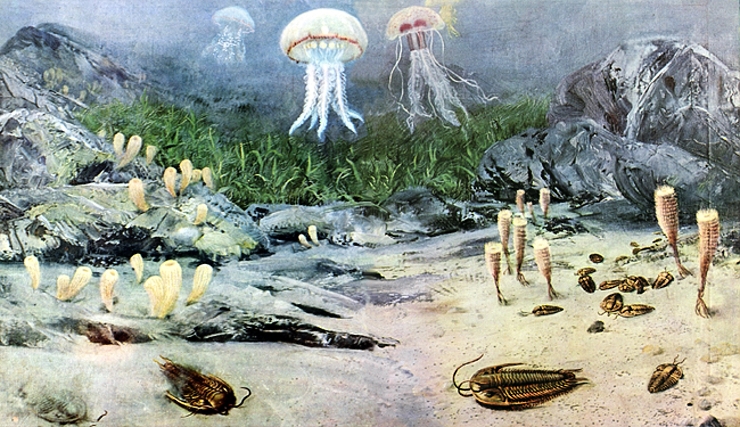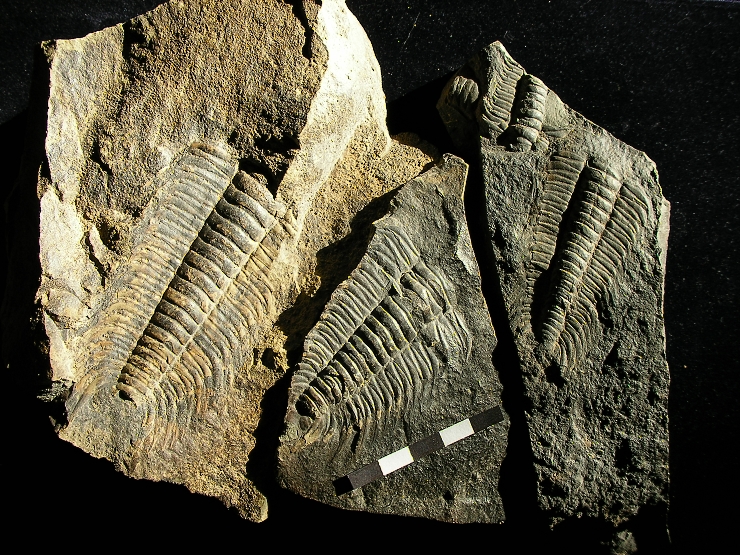Pane kolego, vynikající! Jelikož mám stejné postižení ohledně vášnivého sběru praprazdechlin uvězněných v kameni, mé srdce plesá  Mimochodem, máš moc pěkný vzorky. Já, jelikož žiju na křídové pánvi musím za paleozoikem dojíždět a ač se mi docela hromadí taky zajímavé kousky, tak některé druhy, co tu prezentuješ mi zatím chybí - halt se tam dostávám jen několikrát do roka. Kdybys chtěl časem rozjet seriál o druhohorách, tak pro svrchní křídu bych ti moh poskytnout hromadu fotek.
Mimochodem, máš moc pěkný vzorky. Já, jelikož žiju na křídové pánvi musím za paleozoikem dojíždět a ač se mi docela hromadí taky zajímavé kousky, tak některé druhy, co tu prezentuješ mi zatím chybí - halt se tam dostávám jen několikrát do roka. Kdybys chtěl časem rozjet seriál o druhohorách, tak pro svrchní křídu bych ti moh poskytnout hromadu fotek.
The Prehistoric World, Volume One-Cambrium
Categories: Finds and rescue research in the Czech Republic
Welcome to the first episode of Prehistoric World. In this series I will introduce the individual periods of the Protohistoric period and the most famous Czech sites where you can find the remains of the fauna and flora of that time.
The Cambrian, the oldest formation of the Protohistoric period, which is dated to 542 million years ago, and the end to about 488 million years ago. The first mass distribution of multicellularof organisms, the Cambrian explosion, when the first representatives of all modern animal tribes were created. This explosive rise of life took place over a period of about 10 million years and was probably caused by a sharp increase in the oxygen content of theand a change in the mineral composition of the oceans, which allowed animals to form solid shells capable of fossilization. Therefore, the Cambrian is the first period when numerous remains of multicellular organisms first appear in rocks. The leading Cambrian animal is the trilobite. Their fossilized shells make up up to 2/3 of the fauna found, and another less than a third is represented by ramen-bearing animals. However, this preserved abundance represents only less than 10% of the total life on the bottom of the seas at that time. The exact distribution of continents in the Cambrian is not precisely known. The Bohemian basin was probably located in the temperate latitudes of the southern hemisphere, at the western edge of the supercontinent Gondwana.
Locations
The richest and most European sites of the Middle Cambrian are located in the Scythian-Týřovice area and in the Příbram-Jinecké basin, in the area of present-day Brda. Here, volcanites, and especially sediments of the Jiznian Formation, belonging to the Cambrian Drum Stage, 505-500 million years old, with a very rich marine fauna, rise to the surface.
The Vystrkov peak, probably the most famous excursion site. On its southern slopes, between the hill itself and the village of Velci, you can find very abundant body parts of the tiny (about 1-4 cm) trilobite Ellipsocephalus hoffi in the grey-green dusty rocks . Whole shells or groups of trilobites are also quite common. Stratigraphically, the locality belongs to the upper part of the Jiznik Formation. On the western slopes you can find a community of animals similar to those found in Felbabka, with the leading trilobite Paradoxides gracillis.
Felbabka, the site where I started. On the southern and southwestern slopes of Mount Sharp, blue-brown dusty shales, mined in several large collecting pits, rise to the surface. The most abundant finds here are cephalons (heads) and variously sized body parts of the predatory trilobite Paradoxides gracillis, with occasional whole juvenile stages about 1 cm long. Another abundant find is the blind trilobite Conocoryphe sulzeri. Mostly its heads are found, but it is not such a problem to find whole individuals, usually up to 5cm in length. Peronopsis integra, a small scavenging arthropod formerly classified as a trilobite, is also relatively abundant.
On the River Crescent, I personally don't have much experience with this site. It is located to the right of the road from Rejkovice to Jince, on a steep slope, about 700m south of the railway station in Rejkovice. In the grey-blue dusty shales exposed in several large mining pitsand in the rubble on the slope, you can find a fauna very similar to that of Felbabka and the western slopes of Vystrkov. The advantage of this site is that it is not as well known as the two mentioned above.
Rejkovice - In the Yellow, my favourite locality of the older part of the Jiznian Formation. In a massive incision of the forest road, brownish purple dusty rocks stand out in several pits, with the leadingm, the predatory trilobite Eccaparadxides pusillus , and Ellipsocephallus vetustus-a larger relative of the Ellipsocephallus of Vystrkov. Small fragments of their shells are abundant, but whole individuals are not rare. The specimens from this locality are, in my opinion, among the most aesthetic, as the fossils here are covered with a bright yellow layer of limonite.

The Cambrian Sea by Zdeněk Burian

World map of the Younger Cambrian

Ellipsocephalus hoffi, locality Vystrkov

eccaparadoxides pusillus, locality Ve Žluté

Thoraxes of Paradoxides gracilis, Felbabka

Agnostid Peronopsis integra, locality Vystrkov

Conocoryphe sulzeri, locality Felbabka

Cephalon of Paradoxides gracilis

Hypostome Paradoxides gracilis
probably Eccaparadoxides pusillus

Peronopsis integra, locality Felbabka
The article is included in categories:
Post
Jsem rád že se líbí, a že nás stejně postižených je tady více  Shodou okolností také pocházím z pískovců, a za prvohorami musím dojíždět přes půlku Čech, takže jsem rád, když se alespoň dvakrát za rok někam dostanu.
Shodou okolností také pocházím z pískovců, a za prvohorami musím dojíždět přes půlku Čech, takže jsem rád, když se alespoň dvakrát za rok někam dostanu.
Druhohory se snad také dostanou do plánů. Křídových fosilií mám kolem dost, jen jsem zatím nenarazil na kousky hodné prezentace. Ale třeba je to jen tím, že tu nemáme opuky a jiné jemnozrnity.
Osobně mě zajímají právě prvohory, a potom až třetihorní flóra uhelných pánví našeho kraje.
Kurňa o Ostrým jsem neměl ponětí a nemam to tak daleko, to je na český straně, či německý?  Jinak pěkný počtení
Jinak pěkný počtení 
Lucky: Všechno jsou nálezy z Čech, z okolí Brd.
Díky za ten článek, parádní.
Sám se chystám na ten Vystrkov, jelikož už déle toužím najít nějakého toho trilobita a pokud si dobře vzpomínám, tak mě na tuto myšlenku navedl film Cesta do pravěku 
Hezkej článek 
Taky tyhle prvohorní potvory rád hledám (ono na Berounsku se tomu nejde ubránit  )
)
Marku, ty jsi tam ještě nebyl? :) Když dopadne počasí, tak se tam o svátcích chystáme z mlaďochy :)
Parádní článek, moc díky, těším se na další díly.
Luxusní článek, fotky, lokality, ta mapa Kambria to teda čumím. Budu muset také některou z lokalit navštívit.
Jinak dotaz, je možné používat kladívko nebo jenom povrchový sběr.
Díky a těším se, pokud budou i další díly v tomto duchu. 
To goldikem: myslím že bez kladiva je to jenom procházka. Pokud to vezmu čistě z naší praxe :)
Kladívko rozhodně s sebou, většinu nálezů mám z proklepávání suti, ale přiznám se, že jsem si i párkrát kopnul do skály.
Povedený článek pane kolego, je vidět, že jsem krom zahradníka také dobrým kameníkem
Marku náčelníku, ještě ne, je to přece jen od Ostravy dále, takže to budu muset ještě spojit s něčím jiným a taky, je brzy tma, tak počkám, až bude se den prodlužovat 
Jince má domovina  už ve školce jsme chodili ,,na trilobity" 😀
už ve školce jsme chodili ,,na trilobity" 😀
Moc hezky napsáno,děkuji.
Marky: chce to si tam zařídit ubytování. Spát na kopci je trochu problém, je to CHKO a v létě tam spal kamarád a bylo to z lehkým dohadováním, jako že v lese se už spát nesmí atd. A to tedy nedělali žádný táborák. Pro mě, postaršího trempíka je tohle trochu frustrující...
VendelinDindung : no teda až bude pěkně tak bych se přidal 
Máro, uvidím, jak tam pojedu a s kým všechno, sám bych se vyspal třeba v autě. Ale z Prahy to je hodina cesty, tak se klidně vyspím v Praze u rodiny 
kocab - no, budu o tom uvažovat  Ale dříve než někdy na jaře tam nepojedu, teď jsou krátké dny
Ale dříve než někdy na jaře tam nepojedu, teď jsou krátké dny 
Pěkný článek těším se na pokračování. Z Olomouce celkem z ruky,ale v létě budu muset vymyslet nějaký výlet a nějakou lokalitu navštívit.👍👍👍





















